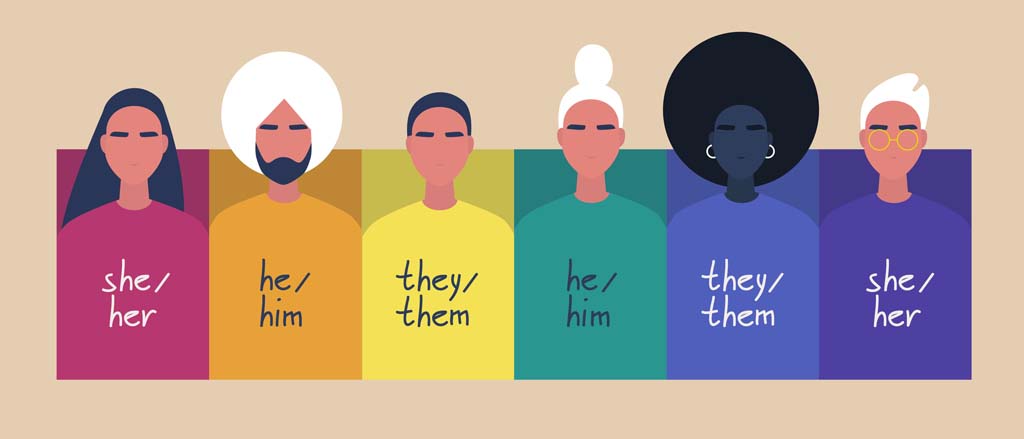
Pronouns: what they are, why they matter, and how you can enter them into the Payworks system
Even if your AP English class days are long behind you, you’ve likely heard a lot about pronouns in recent years. Maybe you’re wondering why they’re such a hot topic, and why understanding them is so important! You might also be fearful of making a mistake, inadvertently hurting someone about whom you care, or feeling judged for not understanding the full weight of using pronouns correctly.
To start - let’s put that fear behind us. As the world evolves, so does our understanding! There’s no shame in the fact that “you don’t know what you don’t know.” However, it’s each of our responsibilities to not only remain open to learning but also to seek out opportunities to “know better; do better.”
With that in mind, today we’ll be exploring what pronouns are, why they matter, and how you can put your learnings into practice (including within the Payworks application!).
What are pronouns?
Pronouns are words used to replace a noun in a sentence. In the past, when we’ve spoken about an individual in the third person, we’ve often used “she/her” or “he/him” rather than using the person’s name every time they’re the subject of the sentence. Interestingly enough, this isn’t universal; languages like Japanese, Tagalog, and Haitian Creole don't gender their nouns at all.
However, languages that have followed this pronoun structure in the past have evolved to distinguish between sex assignment at birth and gender identity. According to the World Health Organization, “gender identity refers to a person’s deeply felt, internal and individual experience of gender, which may or may not correspond to the person’s physiology or designated sex at birth.” Gender is often defined within (and also limited by) the context of societal norms.
With this distinction in mind, pronouns are now tied exclusively to gender identity: “she/her” for someone who identifies as female, “he/him” for someone who identifies as male, and “they/them”, “xe/xem”, “ze/hir” or many other options for those who identify outside of the traditional gender binary.
Why does this matter?
In our workplace, we frequently use pronouns to identify people, and using someone’s appropriate pronoun is just as important as calling them by their correct name. It shows respect, builds trust, fosters an environment of inclusivity, and helps others feel empowered and take ownership of themselves and their identity. Conversely, misgendering someone can lead to them feeling isolated, threatened and marginalized, and sends a message to them that they’re not important. Studies have shown that using correct pronouns raises a person’s self-esteem, and lowers rates of depression and even suicide.
How can Canadian businesses normalize the usage of pronouns?
Here are some ideas:
- Use your own pronouns in conversation. Introduce yourself with them: “Hi, I’m Charlie. My pronouns are she/her/hers. Nice to meet you!” This type of introduction signifies that it’s safe for others to share their pronouns if they choose. You can ask what someone’s pronouns are, but understand that they’re not obligated to tell you (and that it’s rude to ask someone to explain why their pronouns are what they are). Not sure what pronoun to use for someone you’re addressing, and don’t want to ask? Use a gender-neutral pronoun (they/them/theirs). You’ve probably had a lot of practice with this without even thinking when you say things like, “I wonder when they’ll get here,” or “Tell them I say hi!”
- Add your pronouns to your email signature, display name on virtual meeting platforms, social media accounts, and more. It’s becoming increasingly common for software and apps to have these fields available (including the Payworks application – but more on that below!). Look for opportunities to opt in.
- If you make a mistake when speaking to someone, apologize, correct yourself, and continue your conversation. Repeatedly apologizing and explaining how badly you feel for getting it wrong will then turn the mistake into something about you and your feelings, when what matters most is showing simple respect to the other person.
- Be kind. Don’t mock anyone or single them out for their pronouns. Being nice doesn’t cost anything and helps others feel safe – a win-win!
- Continue educating yourself. You’re reading this article for a reason, and we’re so glad you’re here! Continue your learning process with an open mind and heart, and don’t be afraid to try (and fail). Showing you’re making an effort is appreciated.
- Explore other resources:
- We love the website pronouns.org.
- For book recommendations, see this list from The Guardian or this list from Queer in the World.
Here’s a handy table to illustrate the different types of pronouns (note: as language evolves continuously, this is not an exhaustive list, but rather serves as an example of how different pronouns are applied):
|
Subjective |
Objective |
Possessive Adjective |
Possessive Pronouns |
Reflexive |
|
He |
Him |
His |
His |
Himself |
|
She |
Her |
Her |
Hers |
Herself |
|
They |
Them |
Their |
Theirs |
Themselves |
|
Ze |
Zim (rhymes with them) |
Zir (rhymes with their) |
Zirs |
Zirself |
How can I start applying pronouns within the Payworks application?
For Payworks clients, authorized account administrators and employees can enter pronouns into the Pronouns field on the Employee Information screen of our Payroll and Human Resources solutions.
Pronouns can be selected from a pre-determined list that includes “she/her,” “he/him,” and “they/them,” but there’s also an option to enter a custom pronoun combination on an individual employee basis.
Payworks clients in need of assistance can reach out to their dedicated Client Service Representative (CSR) at any time for a helping hand!
Key topics in this article:
InnovationPayroll ResourcesFinanceBusiness OwnerHR ManagementSMEFranchiseeHospitalityPayroll ManagementThese articles are produced by Payworks as an information service. They are not intended to substitute professional legal, regulatory, tax, or financial advice. Readers must rely on their own advisors, as applicable, for such advice.














